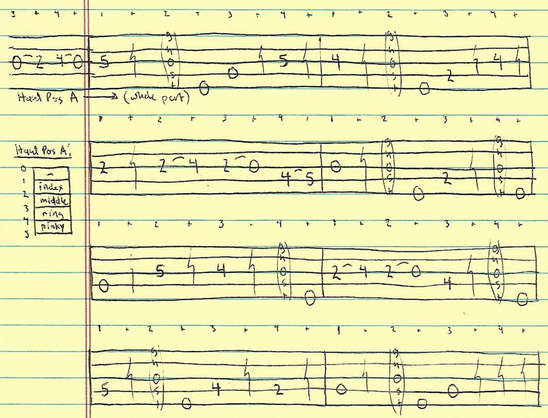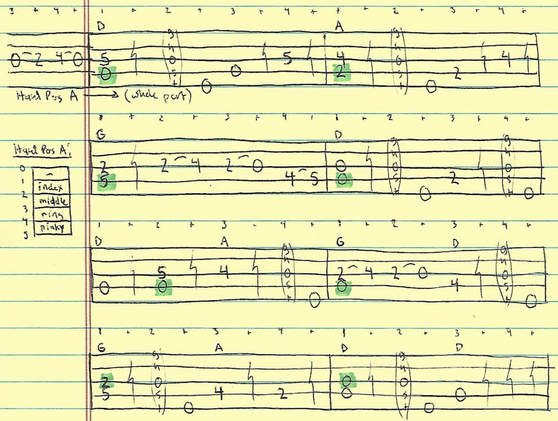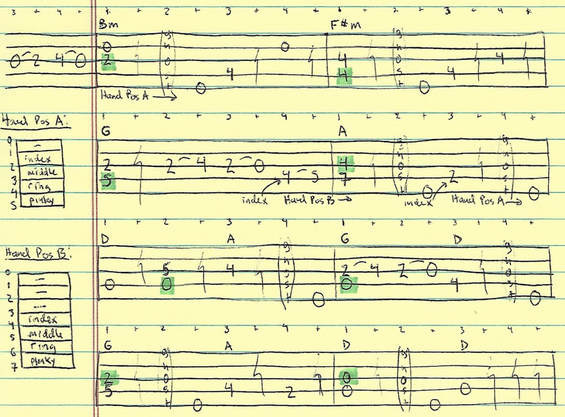|
This week I thought I'd talk a bit about double stops, a technique I find myself using in my playing fairly often these days. Before going further, I'll give a definition: a "double stop" is just a fancy a fiddle term for playing two notes on adjacent strings at the same time. I'm not sure the term is typically applied for non-bowed instruments but whatever, I'm using it anyhow. Since we're playing clawhammer, we'll use the striking finger to hit both strings at the same time (i.e. we wont, for instance, pluck one string with the index and one with the thumb). This technique takes a bit of control and is probably easier with a good fingernail, but I'm willing to bet that there's not too much of a learning curve if you haven't tried it before - heck, every player has likely done it by accident at least a few times.
Double stops are pretty useful in that they let you play a second note to harmonize melody notes. You could use this technique to play parallel harmonies; for an example of this, check out figures 21-23 of my "27 variations on the walk-up in Spotted Pony" post (here). Today however, I'll talk about using double stops to "suggest" chordal accompaniment instead. For this discussion, we'll focus on the B part of "Coleman's March," a tune into which I frequently pepper double stops. Figure 1 shows how I play the B part with all the bum-ditty chords removed while maintaining right hand stride through the magic of ghost notes (I previously used this trick to avoid over-harmonizing my modal exploration of "Coleman's March" here):
Figure 1 - The B part of "Coleman's March" with all the chords removed
(meant to be played in double D tuning - aDADE).
You can hear my play the above tab in Example 1 below:
Example 1 - Me playing Figure 1 on my nylgut-strung Buckbee (here) tuned to double D.
Perhaps a little bland huh? Figure 1 is basically a blank canvas upon which we can overlay some harmony to spice things up. One option would be to simply add chords back in where the ghost notes were. However, thats a bit heavy handed for a pretty tune like this one and (to echo a few complaints that I've seen on banjohangout), constant strumming on the 2 and 4 beats (i.e. playing straight "bum-ditty" banjo) feels overly bluegrassy to some. Double stops to the rescue!
Adding double stops to suggest chords in "Coleman's March" Before suggesting chords with double stops, we've got to pick a set to go with. Here's the standard set of chords I often play for the B part of this tune: Standard chords for the B part of "Coleman's March:" D D A A G G D D D A G D G A D D My strategy for this exercise is to add a single double stop at the beginning of every measure. In this way, I'm emphasizing the "1" beat and therefore not "bluegrassifying" my old time music : ) Since each measure would last for 2 chords, with each chord representing a single "boom-chick" for a guitarist, I end up using every other chord above (those I've put in bold). Figure 2 shows what I came up with:
Figure 2 - The B part of "Coleman's March" with double stops added in to suggest a standard set of chords (meant to be played in double D tuning - aDADE). Notes that have been added to harmonize melody notes are highlighted in green; the "standard set of chords" is also written above the staff.
One thing to note - I decided to move the double stop to the 2nd beat in measure 5 because I just like it better there. Since the D chord lasts for 2 beats, this double stop is still meant to suggest a D chord. Again, let's here it:
Example 2 - Me playing Figure 2 on my nylgut-strung Buckbee tuned to double D.
Pretty nice huh? I find that double stops on the banjo add a lot to a banjo fiddle duet, especially when you're trying to "tread lightly" in a rhythmic sense. Real quick, I'll break down what I've done here. Below you'll see the chord that occurs at the beginning of each measure (again, those shown in bold above) followed by the 3 notes that make up each triad.
Chords I was trying to suggest with double stops in Figure 2: Measure 1 - D major (D, F#, A) Measure 2 - A major (A, C#, E) Measure 3 - G major (G, B, D) Measure 4 - D major (D, F#, A) Measure 5 - D major (D, F#, A) Measure 6 - G major (G, B, D) Measure 7 - G major (G, B, D) Measure 8 - D major (D, F#, A) Note that I've underlined the melody note in each of the above doublestops, and put the harmonizing notes in bold. Obviously double stops don't allow you to get all 3 notes of a chord so you have to make some choices. My strategy was to pick the root note for each chord unless that was too hard to reach (e.g. trying to reach the 5th fret to get the "G" at the beginning of measure 6 makes it hard for me to play the following few notes) or it was already taken by the melody note (e.g. measures 7 and 8). In Measures 1 and 5, I ignored that second suggestion and played octave double stops for fun (...is this really "harmonizing?"...not sure). So lets have a bit more fun with double stops by switching the chords up. Using double stops with chord substitutions As I mentioned in previous posts (here and here), I really like subbing out "vanilla" chords for something a bit more interesting when I've got space to do so. Some people don't care for this practice in an old time context - if you're one of those types please stop reading... ...still with me? Cool. While 90% of guitarists will stick pretty closely to the standard set of chords I outlined above, I've found that its kinda fun to throw some surprises in the first half of the B part. Here is an alternate set of chords for the B part of "Coleman's march:" Alternate chords for the B part of "Coleman's March:" Bm Bm F#m F#m G G A A D A G D G A D D Again, both sets of chords are equally "right" - its just that the so-called "standard" set, or something very close to it, is more popular than the "alternate" set above. Let's use double stops to suggest these alternate chords in "Coleman's March."
Figure 3 - The B part of "Coleman's March" with double stops added in to suggest an alternate set of chords (meant to be played in double D tuning - aDADE). Notes that have been added to harmonize melody notes are highlighted in green; the "alternate set of chords" is also written above the staff.
A couple things to note in Figure 3. First off, I had to sneak the melody note (high D) to an open string in the first beat of the first measure to make room for a harmonizing note on the 2nd string. For similar reasons, I moved the melody note on the first beat of the 4th measure up to the 7th fret, requiring a change in hand position (indicated in the tab - more on left hand positions here). Also, I changed the notes on the 3rd beats of the first and second measure to match the prevailing chords - these aren't really "melody notes" per se...really just filler while we're waiting for the melody to start again.
I'll spare you another "dissect the chords" exercise as above - suffice it to say that I took roughly the same approach when picking harmonizing notes for double stops....I just changed which chords I used for the first half. Enough chatter - let's hear it!
Me playing Figure 3 on my nylgut-strung Buckbee tuned to double D.
Did you like that one? I totally dig it...
As with any chord substitutions, this tactic is best tried out when you're the only chordal instrument (unless you coordinate with your guitarist). I think its nice to play something like Figure 3 once or twice during a banjo-fiddle duet just to change things up. ----- That's it for now - see you next week!
1 Comment
Joris
8/6/2018 09:40:04 am
I'm kinda bingeing yur wonderful blog right now, and next to the wealth of new information for me I'm finding that we share a lot of stylistic preferences, though your playing is quite a way ahead of mine. I love double stops, especially in Double D. Your posts on chord substitutions were a bit daunting for me, but in combination with the double stops, I definitely have to give that a go. Thanks!
Reply
Leave a Reply. |
-----
|



 RSS Feed
RSS Feed